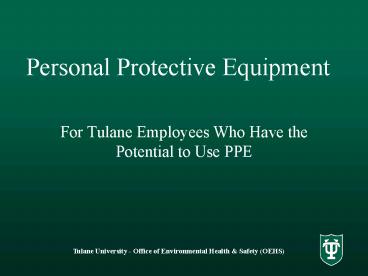Personal Protective Equipment - PowerPoint PPT Presentation
1 / 15
Title:
Personal Protective Equipment
Description:
To understand why a worker should not wear personal protective equipment outside ... To know how to store personal ... Types of Protective Clothing. Aprons ... – PowerPoint PPT presentation
Number of Views:195
Avg rating:3.0/5.0
Title: Personal Protective Equipment
1
Personal Protective Equipment
- For Tulane Employees Who Have the Potential to
Use PPE
2
Objectives
- To know how to assess work area for personal
protective equipment use - To understand the importance of providing
adequate amounts and sizes of personal
protective equipment - To understand why a worker should not wear
personal protective equipment outside
workstations - To know how to store personal protective
equipment properly
3
Assessment of Work Area for Personal Protective
Equipment
- Each work area ( lab, shop, studio) that uses
hazardous materials, works with potentially
infectious substances and / or work with
equipment that can pinch, compress, or radiate
intensive heat or light must assess the need for
personal protective equipment when work practices
and/or engineering controls do not lessen or
eliminate these hazards
4
Assessment of Work Area for Personal Protective
Equipment
- Assessment for personal protective equipment must
be done per hazard (physical and/chemical) - Chemical
- Biological
- Radiological
- Noise
- Vibration
- Light
- Assessment for personal protective equipment must
be done per area of body the hazard will affect - Assessments must be done every two years and/or
when new personal protective equipment is needed.
5
Assessment of Work Area for Personal Protective
Equipment
- Areas of the body in which assessments must be
done are as follows - Head eyes, ears, respiratory
- Hand wrist, fingers and palms
- Body Torso and legs
- Foot Shins and feet
6
Assessment of Work Area for Personal Protective
Equipment
- Once the need for personal protective equipment
is established, then equipment must be acquired
for each worker that the hazard affects. - Personal protective equipment shall be made
available in adequate amounts and different
sizes. - Personal protective equipment must be stored in
accordance with manufacturer suggestions that it
will not be damaged, distorted or contaminated.
7
Use of Personal Protective Equipment
- All who wear personal protective equipment must
be trained on its uses, limitations and proper
decontamination /storage. - Those who wear personal protective equipment must
not wear it outside their work area - If personal protective equipment is reusable, it
must be properly cleaned and decontaminated
before it is removed and stored. - All personal protective equipment must be stored
in a clean and safe manner
8
Types of Eye Protection
- Safety glasses
- Splash goggles
- Prescription safety glasses must be made
available (if required) by departmental
supervisors - Notes
- Contact lenses do not provide eye protection
unless worn with safety glasses or goggles. - Face Shields alone do not offer eye protection
they must be used with safety glasses or goggles
9
Types of Protective Clothing
- Aprons
- They must be cleaned if contaminated with
hazardous materials - They must be replaced if torn, ripped or tattered
- Chemical Suits
- If disposal able, they must be handled properly
and discarded as hazardous waste - If reusable, they must be properly cleaned
,decontaminated and stored for next use. - Laboratory Coats
- Must be worn only inside the work area
- Must be removed before leaving work area for
breaks, lunch and end of the work day. - Must be cleaned by a professional cleaning
service DONT TAKE HOME LAB COATS FOR WASHING
10
Types of Hand Protection
- Latex Gloves
- Supervisors must supply adequate supplies and
sizes - Work and supervisor should be aware of latex
allergies - Rubber Gloves
- Must be worn when working with highly corrosive
or toxic materials - Must be cleaned, decontaminated and stored
properly after each use - Temperature Resistant Gloves
11
Types of Foot Protection
- Rubber Booties
- Chemical Resistant Shoes
- Steel-toe Shoes
- Surgical Coverings
12
Respiratory Protection
- TB- Masks Respirators
- Chemical Gas Respirators
- Dust / Particles Respirators
13
Respiratory Protection
- Respiratory protective equipment is need when
work practices and engineering controls cannot
eliminate the inhalation hazard. The selection
and type is based on the air contaminate. The
following must be done in order to wear a
respirator - The wear must receive OEHS written policies and
procedures for respiratory protection - The worker must be clean shaved
- The wear must have a medical evaluation to
determine the wears ability to wear a respirator - The worker must be fit-tested by OEHS on an
annual basis or when the worker facial features
has changed dramatically
14
Summary
- PPE assessment forms must be filled out and
submitted to OEHS every three years - PPE must be adequate for the job and various in
sizes and styles must be provided - Personal protective equipment must not be worn
outside workstations - Personal protective equipment must be stored
properly so that it will not be damaged
15
Tulane UniversityOffice of Environmental Health
Safety (OEHS) www.som.tulane.edu/oehs Bruce
McClue, Hazardous Waste Supervisor (504)
988-2865 / bmcclue_at_tulane.eduIf unable to
proceed to quiz, type the link below into your
browserhttp//aurora.tcs.tulane.edu/ehs/enterssn.
cfm?testnum16
Proceed to Quiz































